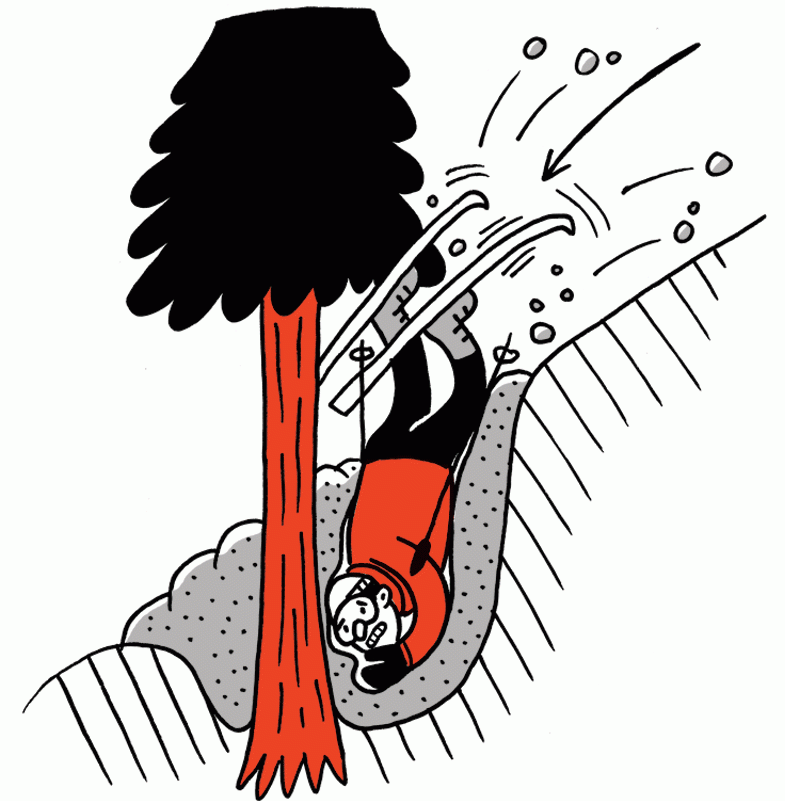Safety on Powder Days: How to Not Be a Jerry Part Two
January 31, 2017
The day after the latest storm is a beautiful, bluebird day. Despite the multiple minor injuries you sustain from your collision in the terrain park two weekends ago, your friends convince you to go skiing with them – the powder is so fresh! Mammoth Mountain has just broken its monthly snowfall record! The backcountry is sick right now! And so, you pack up the car and head to the hills, ready to shred.
That morning, as you packed for your ski trip, the radio announced that the mountains had recently gained a foot and a half of fluffy, powdery snow, and it was all yours for the taking. You packed your mohawked helmet (you learned after last time), your aggressively green snowsuit, and of course, Ol’ Reliable, your fanny pack that you always wear when you ski. Although your friends and you decided to ski the backcountry to get the really deep pow, you unfortunately neglected to pack equipment like whistles, shovels, and beacons, which come in handy in emergencies.
As you near your snow-cloaked destination, you think to yourself: I know all the safety tips now. There’s no way I will get hurt again! Powder is soft! I’m no Jerry!
But riding powder is much different than riding groomers or terrain parks. In fact, powder can be very dangerous, and if you don’t know the basic safety rules…you are still a Jerry.
SIS – snow immersion suffocation – is just one of the dangers of skiing or snowboarding in powder, especially outside of patrolled areas. SIS can occur in loose powder, but is especially common when a skier or snowboarder becomes trapped in a tree wells. (Tree wells are depressions in the snow below the branches of trees.)
Fortunately, there are ways to prevent snow immersion suffocation and to get yourself – or a partner – out of a potentially fatal circumstance. According to deepsnowsafety.org, here are the best ways to prevent SIS, or to rescue someone from potential SIS.
Prevention:
- Always ride with a partner or partners. When riding somewhere with low visibility, regroup often after riding short distances. It is important to keep an eye on your partner at all times – most victims of SIS had been riding with a partner, but their partner had not paid attention to the whereabouts of the person they were with.
- The best way to entirely avoid tree wells is to stay on groomed runs!
- While not all tree wells are not threatening, it is best to consider all as being dangerous. Avoid tree wells and other places where loose powder can accumulate, such as creek beds and steep drops.
- Skiers – remove ski pole straps from around your hands! You might need to dig yourself out of a snowy situation.
- Safety equipment you can carry includes:
- cell phone (make sure you have ski patrol/resort emergency number in your contacts!)
- Transceiver or beacon
- Avalung
- Whistle
- Shovel
- Probe
- Recco
And here’s what to do if you find yourself stuck in a tree well:
- Make noise to notify your partner that you might need their help/are in a bad situation
- Maneuver to a position that keeps your head out of the snow (keep your feet below your head, if you can)
- If you are under the snow, keep your airway or airspace safe
- Stay calm, don’t struggle – this helps to conserve air and moving might put you into a more dangerous place
- Trust that your partner is on their way to help
- If you can, contact ski patrol or the resort’s emergency hotline with your cellphone
If your partner is in danger of SIS, here is what you can do:
- Stay with your partner
- Call for help, either by making noise or by contacting ski patrol or a resort emergency number
- Start recovery as soon as you can – but don’t compromise your own safety
- Clear snow from your partner’s airway
- When you are extricating your partner, locate where their head would be and tunnel towards it from the side. Don’t try to get them out the way they fell in
- Be very careful to not block or damage the airway/airspace of your partner!
Enjoy the powder, but be careful – and don’t be a Jerry.
(Feature picture source: snowbrains.com



